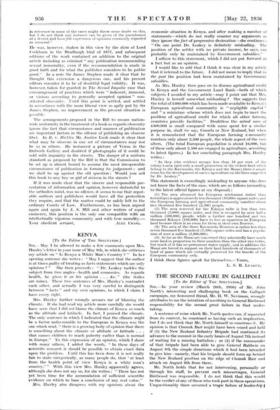KENYA
[To the Editor of TILE SeEcr.vroa.1 Stn,—May I be allowed to make a few comments upon Mrs. Huxley's letter in your issue of May 8th, in which she criticises my article on " Is Kenya a White Man's Country ? " In her opening sentence she writes : " May I suggest that the author is at times guilty of treating as facts statements which are only opinions ? " She then proceeds : " Dr. Leakey tackles the subject from two angles—health and economics. As regards health, he gives it as his opinion . . . &c. " (the italics are mine). These two sentences of Mrs. Huxley's contradict each other, and actually I was very careful to distinguish between " facts " and my own opinions, to which I claim I have every right.
Mrs. Huxley further wrongly accuses me of blaming the climate. If she had read my article more carefully she would have seen that I did not blame the climate of Kenya so much as the altitude and latitude. In fact, I praised the climate. The only sentence in which I indicated that the climate might be a factor unfavourable to the European in Kenya was the one which read, " there is a growing body of opinion that there is something about the climate or altitude or latitude . . . that causes children to reach puberty earlier than is normal in Europe." To this expression of an opinion, which I share, with many others, I added the words, " In these days of . scientific research it should be possible to obtain exact data upon the problem. Until this has been done it is not really fair to state categorically, as many people do, that ' at least from the health point of view Kenya is a white man's country.' " With this view Mrs. Huxley apparently agrees,. although she does not say so, for she writes : " There has not yet been time for the accumulation of sufficient scientific evidence on which to base a conclusion of any real value."
Mrs. Huxley also disagrees with my opinions about the
economic situation in Kenya, and after making a number of statements—which do not really counter my arguments as they ignore the fact of progressive desiccation—she continues : " On one point Dr. Leakey is definitely misleading. The position of the settler with no private income, he says, can probably only be maintained by Government subsidies."
I adhere to this statement, which I did not put forward as
a fact but as an opinion.
I would like to add that I think it was clear in my article
that it referred to the future. I did not mean to imply that in the past the position had been maintained by Government
subsidies.
As Mrs. Huxley then goes on to discuss agricultural credit in Kenya and the Government Land Bank—both of which subjects I avoided in my article—may I point out that Mrs.
Huxley is herself somewhat misleading ? She suggests that the total of £400,000 which has been made available to Kenya's European agricultural community is " negligible capital " and " a miniature scheme which does not begin to meet the problem of agricultural credit for which all other fanning
countries provide facilities." Doubtless the actual sum of £400,000 is small compared with sums spent for a similar
purpose in, shall say, Canada or New Zealand, but when it is remembered that the European farming community numbers only about 2,500 people, the whole aspect of the ease alters. (The total European population is about 16,000, but of these only about 2,500 are engaged in agriculture, according to latest figures.) In her concluding paragraph Mrs. lIuxley writes :
- As they (the settlers) occupy less than 10 per cent. of the
colony's area (and only a small proportion of the richest land which belong to the Kavirondo, the Kikuyu and the Masai) there is ample room for the development of native agriculture on the lines suggested by Dr. Leakey."
This statement is exceedingly misleading to anyone who does not know the facts of the case, which are as follows (according to the latest official figures at my disposal) :
(1) The area alienated for European settlement (other than townships) is approximately ten thousand (10,000) square miles, and the European farming and agricultural community numbers about two thousand five hundred (2,500) people.
(2) The area reserved for the Kikuyu tribe is less than two thousand (2,000) square miles, and this is occupied by over half a million (500,000) people, while a further one hundred and ten thousand Kikuyu (110,000) have to live as squatters on European land because there is no room for them in their own Reserve.
(3) The area of the three Kavirondo Reserves is rather less than seven thousand five hundred (7,500) square miles and has a popula- tion of over a million (1,000,000 ).
(4) As far as the Masai are concerned they admittedly have much more land in proportion to their numbers than the other two tribes, but much of it has no permanent water supply, and in addition the Masai_ are forced to support on their land hundreds of thousands of head of game which are virtually preserved for the benefit of the European community only.
I think these figures speak for themselves.—Yours, L. S. B. LEAKEY.


















































 Previous page
Previous page